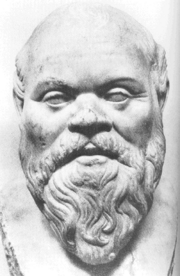History of science in early cultures
|
|
| History of science | ||
| Overview | ||
| Theories and sociology of the history of science | ||
| Pre-experimental science | ||
| Science in early cultures | ||
| History of Medieval science | ||
| Scientific revolution | ||
| Natural Sciences | ||
| Social sciences | ||
| Interdisciplinary | ||
| History of pseudoscience | ||
Timelines for scientific
|
In prehistoric times, advice and knowledge was passed from generation to generation in an oral tradition. The development of writing enabled knowledge to be stored and communicated across generations with much greater fidelity. Combined with the development of agriculture, which allowed for a surplus of food, it became possible for early civilizations to develop and more time to be devoted to tasks other than survival, such as the search for knowledge for knowledge's sake.
| Contents |
Mesopotamia
SumerianClayTablet,palm-sized422BCE.jpg
From their beginnings in Sumer (now Iraq) around 3500 BC the Mesopotamian peoples began to attempt to record some observations of the world with extremely thorough quantitative and numerical data. But their observations and measurements were seemingly taken for purposes other than for scientific laws. A concrete instance of Pythagoras' law was recorded, as early as the 18th century BC: the Mesopotamian cuneiform tablet Plimpton 232 records a number of Pythagorean triplets (3,4,5) (5,12,13). ..., dated 1900 BC, possibly millennia before Pythagoras1, [1] (http://www.angelfire.com/nt/Gilgamesh/achieve.html) but an abstract formulation of the Pythagorean theorem was not.
Astronomy is a science which lends itself to the recording and study of observations: the vigorous noting of the motions of the stars, planets, and the moon are left on thousands of clay tablets created by scribes. Even today, astronomical periods identified by Mesopotamian scientists are still widely used in Western calendars: the solar year, the lunar month, the seven-day week. This collected data enabled the prediction of the motion of some celestial bodies: sun, moon and stars, but not the planets. Only a few astronomer's names are known: Kidinnu was a Chaldean astronomer and mathematician who was contemporary with the Greek astronomers. Kiddinu's value for the solar year is in use for today's calendars. Astronomy and Astrology were considered to be the same thing, a fact proven by the practice of this science in Babylonia by priests. Indeed, rather than following the modern trend towards rational science, moving away from superstition and belief; the Mesopotamian astronogy conversely became more astrology-based later in the civilisation - studying the stars in terms of horoscopes and omens, which might explain the popularity of the clay tablets. Hipparchus was to use this data to calculate the precession of the Earth's axis. Fifteen hundred years after Kiddinu, Al-Batani, born in what is now Turkey, would use the collected data and improve Hipparchus' value for the precession of the Earth's axis. Al-Batani's value, 54.5 arc-seconds per year, compares well to the current value of 49.8 arc-seconds per year (26,000 years for Earth's axis to round the circle of nutation).
Indic
See: Ancient Indian science and technology
The precession of Earth's axis can be used to grasp just how ancient is the study of astronomy; there were astronomers in India 6500 years ago; at that time, the vernal equinox was in Orion (around 4500 BC) as mentioned in the Vedas. These astronomers would mark the beginning of the year with the vernal equinox. The observatories of India and Persia were buildings to facilitate observation with the naked eye, much like the stone circles of Europe. Eventually they were miniaturized into the diptychs and astrolabes in use by the Greeks. These instruments, as well as the gnomon, facilitated development of early astronomy throughout Asia. Fire altars, with astronomical basis, have been found in third millennium cities of India. Their design can be conservatively dated to the 1st millennium BC. Around 1800 BC, Yajnavalkya already advanced a 95-year cycle to synchronize the motions of the sun and the moon. In a treatise from the 6th century, a summary of five astronomical systems can be found.
In medicine, inoculation was practiced in China, India, and Turkey. Inoculation was a precursor to vaccination for smallpox.
Egyptian
Significant advances in Ancient Egypt include astronomy, mathematics and medicine. Their invention of geometry was a necessary outgrowth of surveying to preserve the layout and ownership of farmland, which was flooded annually by the Nile river. The 3,4,5 right triangle and other rules of thumb served to represent rectilinear structures, and the post and lintel architecture of Egypt. Egypt was also a center of alchemy research for much of the western world.
The Egyptian hieroglyphs, a phonetic writing system, has served as the basis for the Phoenician alphabet from which the later Hebrew, Greek, Latin, Arabic, and Cyrillic alphabets were derived. The city of Alexandria retained preeminence with its library, which was so great that it became a symbol for knowledge itself. Much of it was destroyed in fire in the first centuries AD. A huge amount of antique literature and knowledge was lost.
Greek science
Meccanismo_di_Antikytera.jpg
An Italian scholar, Lucio Russo, in his book The Forgotten Revolution, claims science was actually born in the 3rd century B.C., due to the work of personalities like Euclid, Archimedes, Hipparchus, Eratosthenes, Herophilos, Heron, and others.
The level reached by the Greeks in astronomy and engeneering is impressively shown by the Antikythera mechanism.
Euclid's book Elements has been the most important textbook in mathematics till the 19th century.
Many achievements of early european science may have to be reconsidered: many greek manuscripts, preserved by the Arabs, flooded Italy and Europe during the Renaissance. Many of these manuscripts are now lost.
Gr棯-Roman
The systematic search for natural laws can be said to start with Hellenic civilization, which reached its zenith in the 4th century BC, and served as the intellectual background for western civilization up to the time of the Scientific Revolution. The philosophies of Socrates, Plato, and Aristotle being preeminent during this period, while Hippocrates laid the foundations of medicine as a branch of science.
The military campaigns of Alexander the Great spread Greek thought through Egypt, Asia Minor, Persia, and to the Indus River. The resulting Hellenistic civilization produced seats of learning in Alexandria and Antioch along with Greek speaking populations across several monarchies.
Hellenistic geometers such as Archimedes, Apollonius of Perga, and Euclid built upon the work of the Hellenic era Pythagoreans. Eratosthenes used his knowledge of geometry to measure the distance between the Sun and the Earth along with the size of the Earth.
Astronomers like Hipparchus built upon the measurements of the Chaldean astronomers before him, to measure the precession of the Earth. Hipparchus in 129 BC recorded the first star map when he observed a nova, and wished to preserve astronomical record of the stars, so that other novas could be discovered. A copy of his star map was found sitting atop the broad shoulders of a seven-foot statue known as the Farnese Atlas.[2] (http://www.space.com/scienceastronomy/hipparchus_catalogue_050124.html) Ptolemy established many of the constellations used today through the Almagest. The Ptolemaic system also became the dominant model for the motions of the heavens.
Roman era contributions include expanding knowledge of anatomy and physiology by the physician Galen. His primary contribution was to carefully dissect and observe dogs, pigs, and barbary apes, using the results to describe such structures as the nervous system, heart, and kidneys. He demonstrated that arteries carry blood instead of air and added greatly to knowledge of the brain, nerves, spinal cord, and pulse. [3] (http://www.med.virginia.edu/hs-library/historical/antiqua/galen.htm)
The Roman theologian Augustine of Hippo, in his book Confessions, expanded upon Aristotle's philosophies in the areas of thought, memory, and time.
Persia
Scientific studies, especially in medicine and chemistry, were conducted by Sassanid physicians. The Academy of Gundishapur was an early teaching hospital established during this time.
China
Joseph Needham's Science and Civilisation in China lists a number of early discoveries, among which important ones in astronomy and medicine. In astronomy, The book Gan Shi Xing Jing (甘石星经) of the Warring States Period (403 BC to 221 BC) is the earliest star catalogue in the world. An important occasion was July 4, 1054, when Chinese astronomers noted the appearance of a guest star, the supernova now called the Crab Nebula, Messier's M1 (M1 was only the second of seven to be observed in the last 1000 years).
Korea
Korean science is little known in the West but involve significant discoveries, particularly in medicine, and invaluable astronomical records of meteor showers, and eclipses particularly from 1500-1750 in the Annals of the Joseon Dynasty.
Maya
Mayan astronomy was advanced enough to support an accurate calendar.
Notes
Note 1: : p.187, Paul Hoffman, The man who loved only numbers: the story of Paul Erd?nd the search for mathematical truth. New York: Hyperion, 1998 ISBN 0-7868-6362-5


